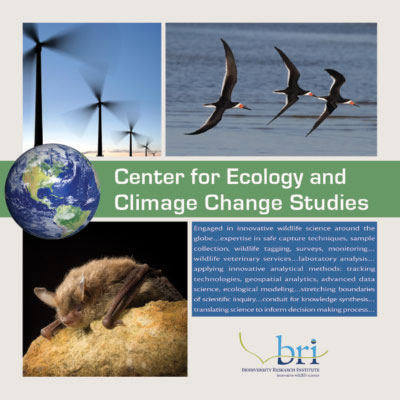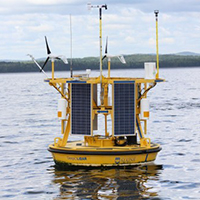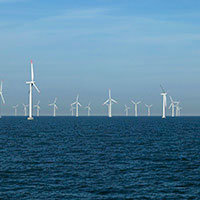Highlighted Species We Study
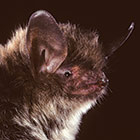
Bats

Sea Ducks

Loons
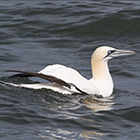
Marine Birds
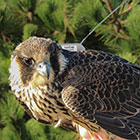
Raptors

Songbirds
BRI’s Wildlife and Renewable Energy Program represents some of the foremost expertise on offshore wind energy development and volant wildlife (e.g., birds and bats) in the eastern United States.
BRI biologists are conducting a range of research, marine spatial planning, and stakeholder engagement efforts to help inform renewable energy development and minimize wildlife impacts. This includes studying the distributions, movements, and habitat use of birds, bats, marine mammals, sea turtles, and other wildlife. This also includes working with stakeholders to identify data gaps and research needs, develop best management practices, and facilitate coordination of research efforts in the eastern U.S.
Our Wildlife and Renewable Energy Program works collaboratively with BRI’s other programs to carry out research studies that cross-species lines and geographic boundaries and enhance our overall knowledge of wildlife and ecosystems that may be affected by the development of alternative energy. Below are examples of the types of projects we have initiated through this program.
Offshore Studies
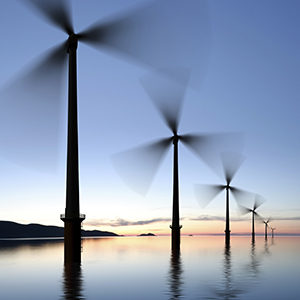
Information from these studies will be used to assess potential risks to wildlife and to attempt to minimize the effects of planned offshore development on wildlife. Since then, BRI has been involved in over 50 offshore wind energy-related research studies. In recent years, a main focus area for the program has been the provision of technical expertise to the Environmental Technical Working Group for Offshore Wind (E-TWG).
Projects related to offshore studies include:
- Offshore Wind in New York State
- Developing Monitoring Protocols for Automated Radio Telemetry at Offshore Wind Farms
- Stochastic Collision Risk Assessment for Movement (SCRAM)
- Identifying Technology Development Priorities for Wildlife Monitoring and Adaptive Management to Mitigate Use Conflicts at Offshore Wind Energy Facilities
- Flight, Fingers, and Fins: Citizen Science to Improve our Knowledge of Landbirds and Bats in the Marine Environment
- Mid-Atlantic Baseline Studies
Coastal Studies
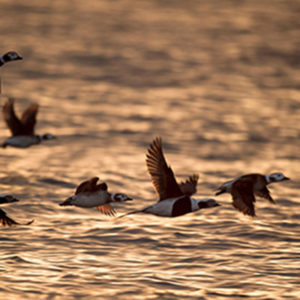
Migrating landbirds and bats can use offshore and coastal areas, including islands. We have conducted a series of coastal and offshore migration studies on bats and migrating birds, including raptors and songbirds.
Projects related to coastal studies include:
- Characterizing the Diurnal and Nocturnal Raptor Migration in Coastal Maine
- Tracking Northern Saw-whet Owls along the Coast of Maine
- Migratory Bird and Bat Monitoring in the Thousand Islands Region of New York State
Terrestrial Studies
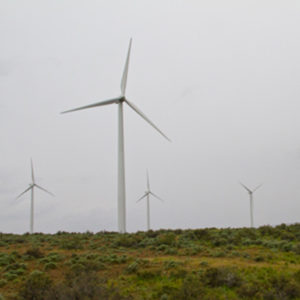
Onshore wind energy and solar development can also present risks to birds and bats. BRI biologists work to understand these wildlife populations and how best to minimize risks of renewable energy development.
Projects related to terrestrial studies include:
- Meta-analysis to compare the effectiveness of curtailment at different cut-in speeds in reducing bat mortality at terrestrial wind farms
- Tracking Eastern Small-footed Bats to Rock Roosts at Acadia National Park
- Stereo-Optic High Definition Imaging
Featured Publications and Reports
- NYSERDA. 2020. Stakeholder Workshop: Scientific Research Framework to Understand the Effects of Offshore Wind Energy Development on Birds and Bats in the Eastern United States. Building Energy Exchange, March 4-6, 2020. NYSERDA Report 20-26. Prepared by J Gulka and K Williams, Biodiversity Research Institute, Portland ME. nyserda.ny.gov/publications
- Stenhouse, I. J., A. M. Berlin, A. T. Gilbert, M. W. Goodale, C. E. Gray, W. A. Montevecchi, L. Savoy, & C. S. Spiegel. 2020. Assessing the exposure of three diving bird species to offshore wind areas on the U.S. Atlantic Outer Continental Shelf using satellite telemetry. Divers. Distrib. 26(12):1703-1714.
- Allison, TD, J Diffendorfer, E Baerwald, J Beston, D Bigger, D Drake, A Hale, C Hein, M Huso, S Loss, J Lovich, D Strickland, K Williams, V Winder. 2019. The ecological impacts of the siting and operation of wind energy in the United States. Issues in Ecology 21:1-24.
- NYSERDA. 2019. The Dynamic Ocean: Offshore Wind Energy and Other Activities in the New York Bight. NYSERDA Report 19-39. Prepared by: KA Williams, I Stenhouse, J Gulka, and D Meattey, Biodiversity Research Institute (Portland, ME). 20 pp.
- Sussman, AL, B Gardner, EM Adams, L Salas, KP Kenow, DR Luukkonen, MJ Monfils, WP Mueller, KA Williams, M Leduc-Lapierre, EF Zipkin. A comparative analysis of common methods to identify waterbird hotspots. 2019. Methods in Ecology & Evolution 10:1454-1468.
- Gulka, JG and KA Williams. 2019. The State of the Science on Wildlife and Offshore Wind Energy Development: Proceedings for a Workshop held November 13-14, 2018, in Woodbury, New York. 84 pp. Available at: https://www.nyetwg.com/past-workshops
- Goyert, HF, B Gardner, RR Veit, AT Gilbert, EE Connelly, M Duron, S. Johnson & KA Williams. 2018. Evaluating habitat, prey, and mesopredator associations in a community of marine birds. ICES Journal of Marine Science 75(5):1602-1612.
- Williams, KA, EE Connelly, SM Johnson & IJ Stenhouse, eds. 2015. Wildlife Densities and Habitat Use Across Temporal and Spatial Scales on the Mid-Atlantic Outer Continental Shelf: Final Report to the Department of Energy Wind & Water Power Technologies Office. Report BRI 2015-11. 715 pp.
2020 State of the Science Workgroup Reports
For the full reports listed below, and to learn more about the New York State Environmental Technical Working Group (E-TWG) click here.
- Carpenter, J.R., K.A. Williams, and E. Jenkins. 2021. Environmental Stratification Workgroup Report for the State of the Science Workshop on Wildlife and Offshore Wind Energy 2020: Cumulative Impacts. Report to the New York State Energy Research and Development Authority. Albany, NY. 14 pp. Available at: https://www.nyetwg.com/2020-
workgroups . - Cook, A., K.A. Williams, E. Jenkins, J. Gulka, and J. Liner. 2021. Bird Workgroup Report for the State of the Science Workshop on Wildlife and Offshore Wind Energy 2020: Cumulative Impacts. Report to the New York State Energy Research and Development Authority (NYSERDA). Albany, NY. 37 pp. Available at https://www.nyetwg.com/2020-
workgroups . - Degraer, S., Z.L. Hutchison, C. LoBue, K.A. Williams, J. Gulka, and E. Jenkins. 2021. Benthos Workgroup Report for the State of the Science Workshop on Wildlife and Offshore Wind Energy 2020: Cumulative Impacts. Report to the New York State Energy Research and Development Authority (NYSERDA). Albany, NY. 45 pp. Available at http://www.nyetwg.com/2020-
workgroups . - Gitschlag, G., R. Perry, K. A. Williams, and E. Jenkins. 2021. Sea turtle workgroup report for the State of the Science Workshop on Wildlife and Offshore Wind Energy 2020: Cumulative Impacts. Report to the New York State Energy Research and Development Authority (NYSERDA). Albany, NY. 22 pp. Available at https://www.nyetwg.com/2020-
workgroups . - Hein, C., K. A. Williams, and E. Jenkins. 2021. Bat Workgroup Report for the State of the Science Workshop on Wildlife and Offshore Wind Energy 2020: Cumulative Impacts. Report to the New York State Energy Research and Development Authority (NYSERDA). Albany, NY. 21 pp. Available at https://www.nyetwg.com/2020-
workgroups . - Popper, A. N., L. Hice-Dunton, K.A. Williams, and E. Jenkins. 2021. Sound and Vibration Effects on Fishes and Aquatic Invertebrates Workgroup Report for the State of the Science Workshop on Wildlife and Offshore Wind Energy 2020: Cumulative Impacts. Report to the New York State Energy Research and Development Authority. Albany, NY. 20 pp. Available at www.nyetwg.com/2020-workgroups
. - Southall, B., L. Morse, K.A. Williams, and E. Jenkins. 2021. Marine Mammals Workgroup Report for the State of the Science Workshop on Wildlife and Offshore Wind Energy 2020: Cumulative Impacts. Report to the New York State Energy Research and Development Authority (NYSERDA). Albany, NY. 50 pp. Available at https://www.nyetwg.com/2020-
workgroups .
Photo Credits: Header photo: © BRI-Jonathan Fiely. Study species: Northern long-eared bat © Merlin D. Tuttle, Bat Conservation International, www.batcon.org; Surf Scoter © Daniel Poleschook; Red-throated Loon © BRI-Jonathan Fiely; Northern Gannet © BRI-Jonathan Fiely; Peregrine Falcon © Al Hinde; Northern Waterthrush © Ken Archer. Northern Gannet with sat tag © BRI-Jonathan Fiely; Wind turbines © iStock; Boat surveys © BRI- Emily Connelly; Bird banding © © BRI-Jonathan Fiely

